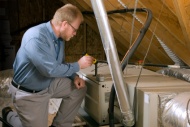Passing the BPI Exam With Energy Auditor Training
STUDY GUIDESA full resource for you to help pass the BPI Exam the first time!
Click for more info... PRACTICE EXAMSWith so many BPI Training Courses, it can be hard to know which one is best. Here are the BEST practice exams you can find that I've personally used and recommend to anyone.
GET THE NEWSLETTERTo get FREE updates and information about all the BPI Exams, please enter your name and email below.
|
BPI Written Exam - Section 1 Building Science Fundamentals20. Understand Input / Output Capacity
Definition of efficiency: input over output capacity. How much useful energy do we get back that we put into a system. How many miles per gallon do we get on a car engine? How much heat is delivered to our homes from every therm that we put in? How much light can we get from a light bulb for every kWh we put in?
I remember when I just got my BPI Certification thinking, "when am I ever going to use the First Law of Thermodynamics (energy can never be created or destroyed) during an energy audit?" Well here is a great application of the First Law of Thermodynamics in understanding input / output capacity, aka efficiency. We never get 100% efficiency out of out appliances, cars, heating and cooling system or any mechanical system for that matter. Only half of power created at a power generating facility actually gets delivered to our homes, so there is a lot of wasted energy that gets unused, but where does it go? The First Law says that energy is never created or destroyed, only transformed. The answer is that all the unused energy gets turned into heat... which means we end up paying for something we are not getting. Enter energy efficiency and input over output capacity. Naturally, we want the highest efficient heating and cooling system we can afford and good gas mileage for our cars. How do we find the efficiency of our appliances or major home systems? It is by a simple formula, input / output. How much energy do we get back, that we put into our appliance. Common ways to express input energy are below:
More on equipment efficiency terms. HTML Comment Box is loading comments...
1a. Basic terms and definitions
1b. Principals of energy, air & moisture
1c. Combustion science
|
The main topics of the BPI BA exam are listed out below. Click on a link that interests you, or you need some brushing up on to learn more on each subject.
1. Building Science Fundamentals 1a. Basic terms and definitions 1b. Principals of energy, air & moisture 1c. Combustion science 2. Buildings and Their Systems 2a. Building components 2b. Conservation strategies 2c. Comprehensive building assessment process 2d. Design considerations 3. Measurement and Verification of Building Performance 3a. Applied diagnostics and troubleshooting 4. BPI National Standards and Project Specifications 4a. Comprehensive building assessment 5. Analyzing Buildings Systems 5a. Comprehensive building assessment 5b. Appliances and lighting 6. Conduct and communications 6a. Conservation strategies |

